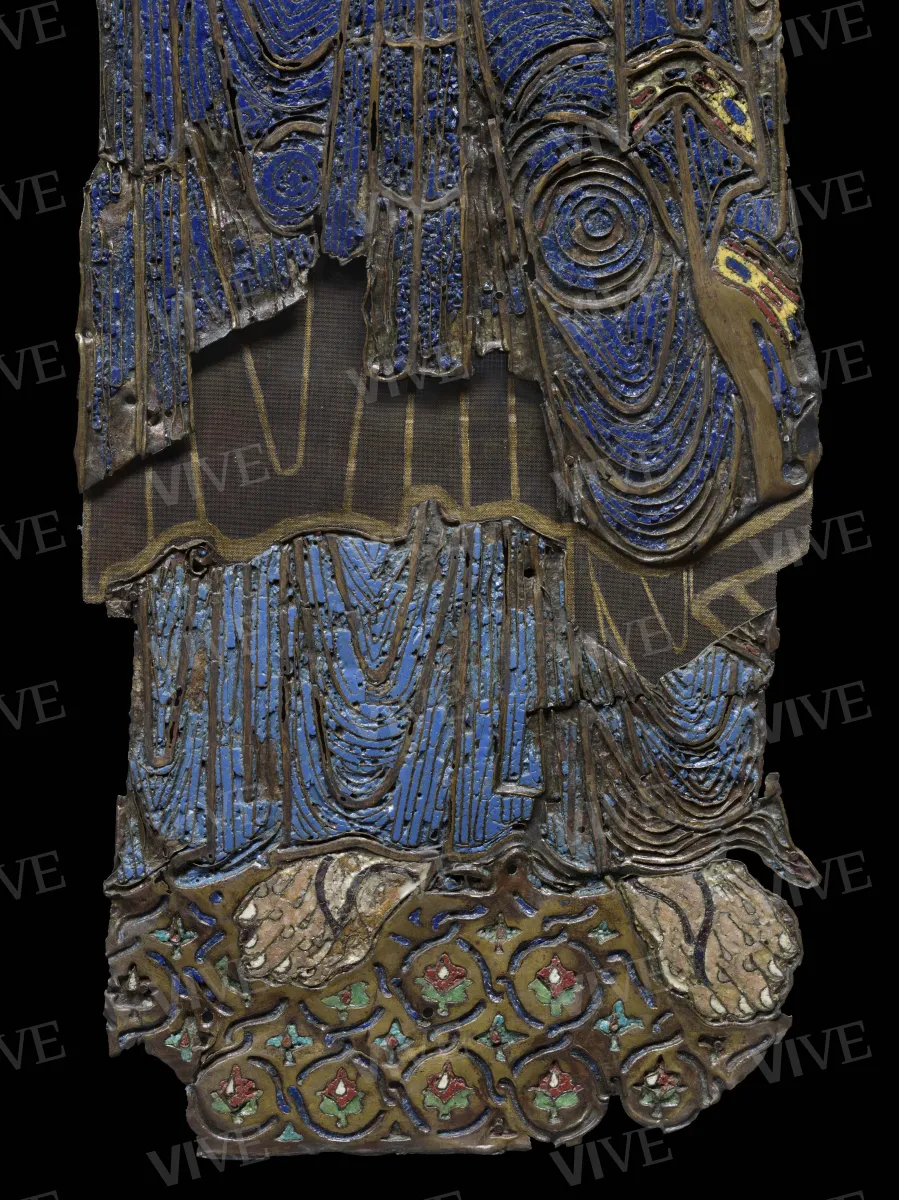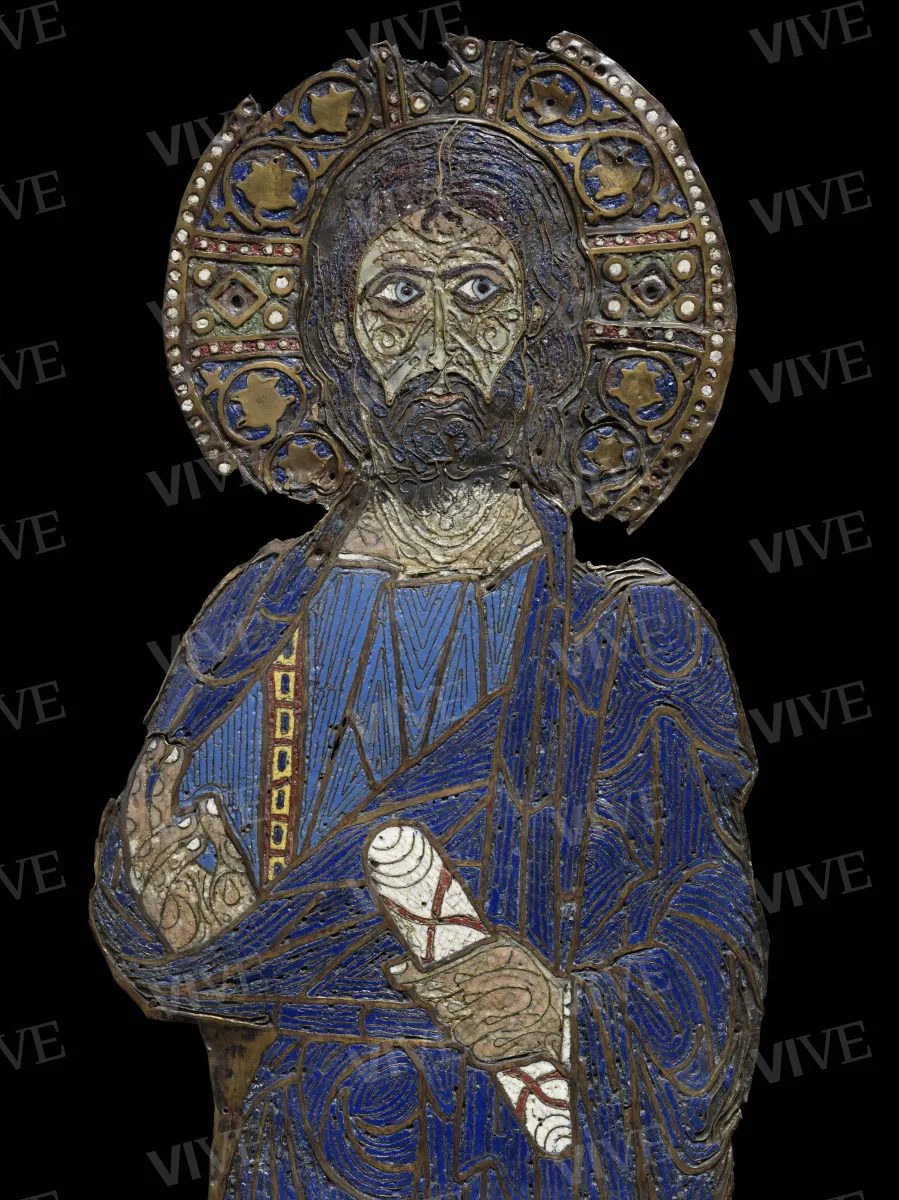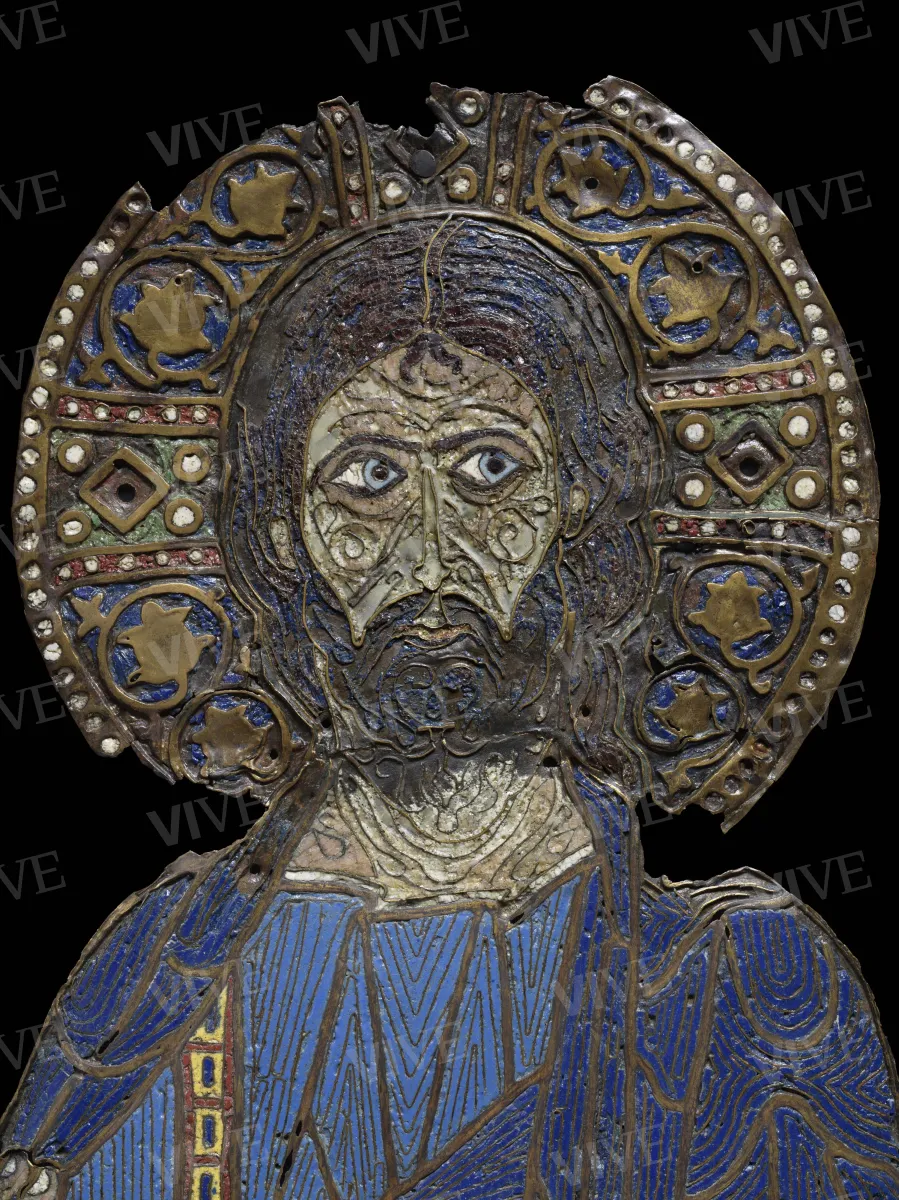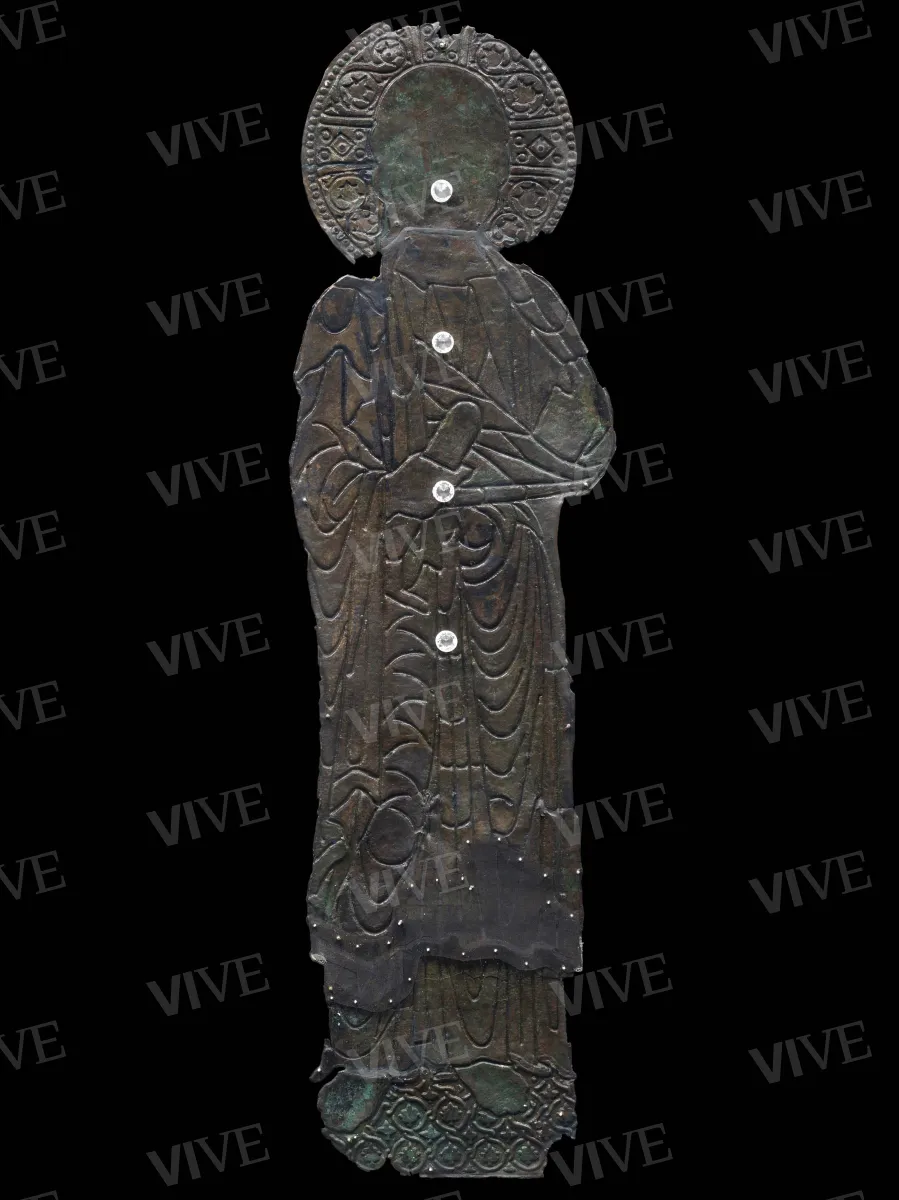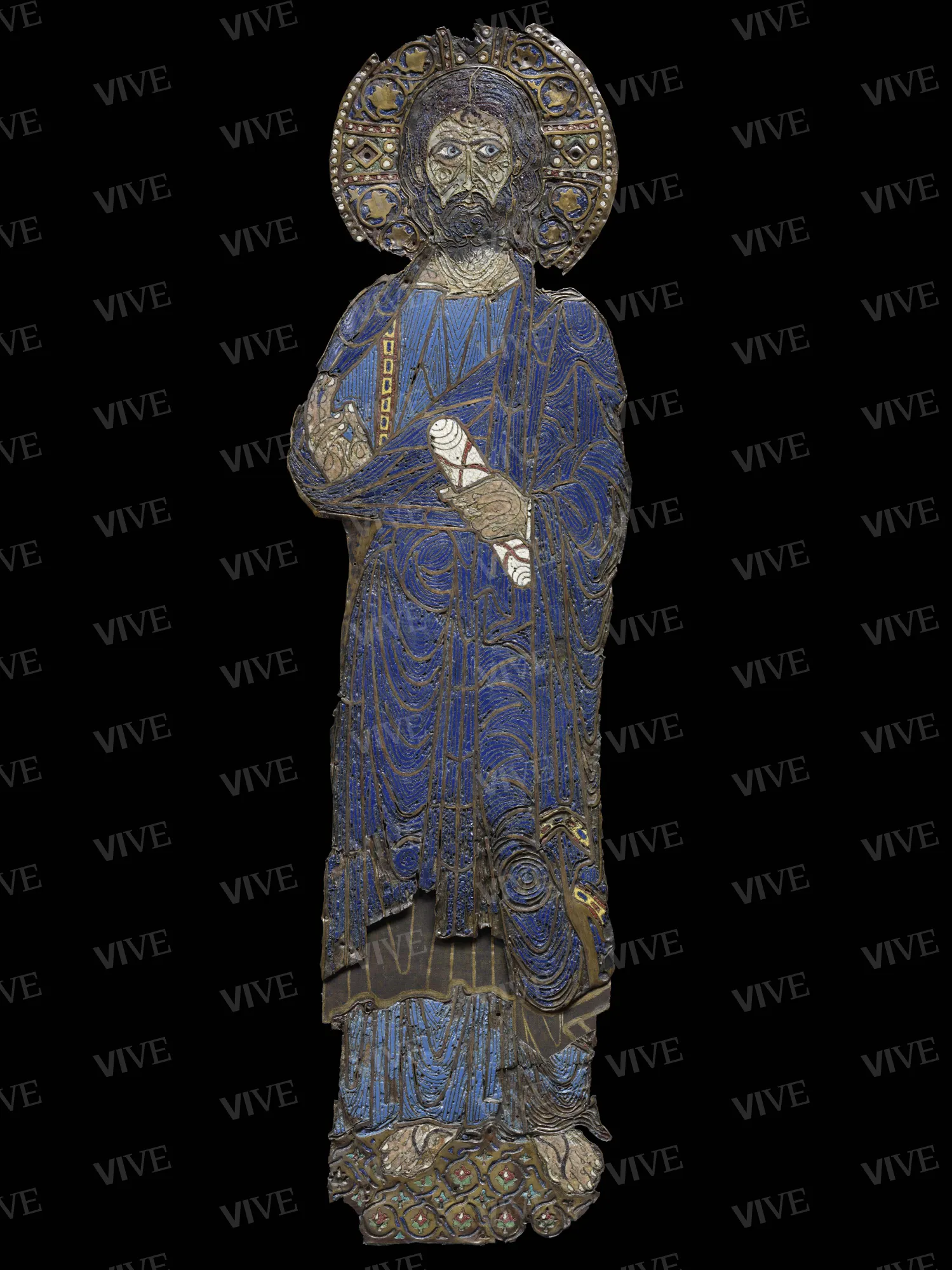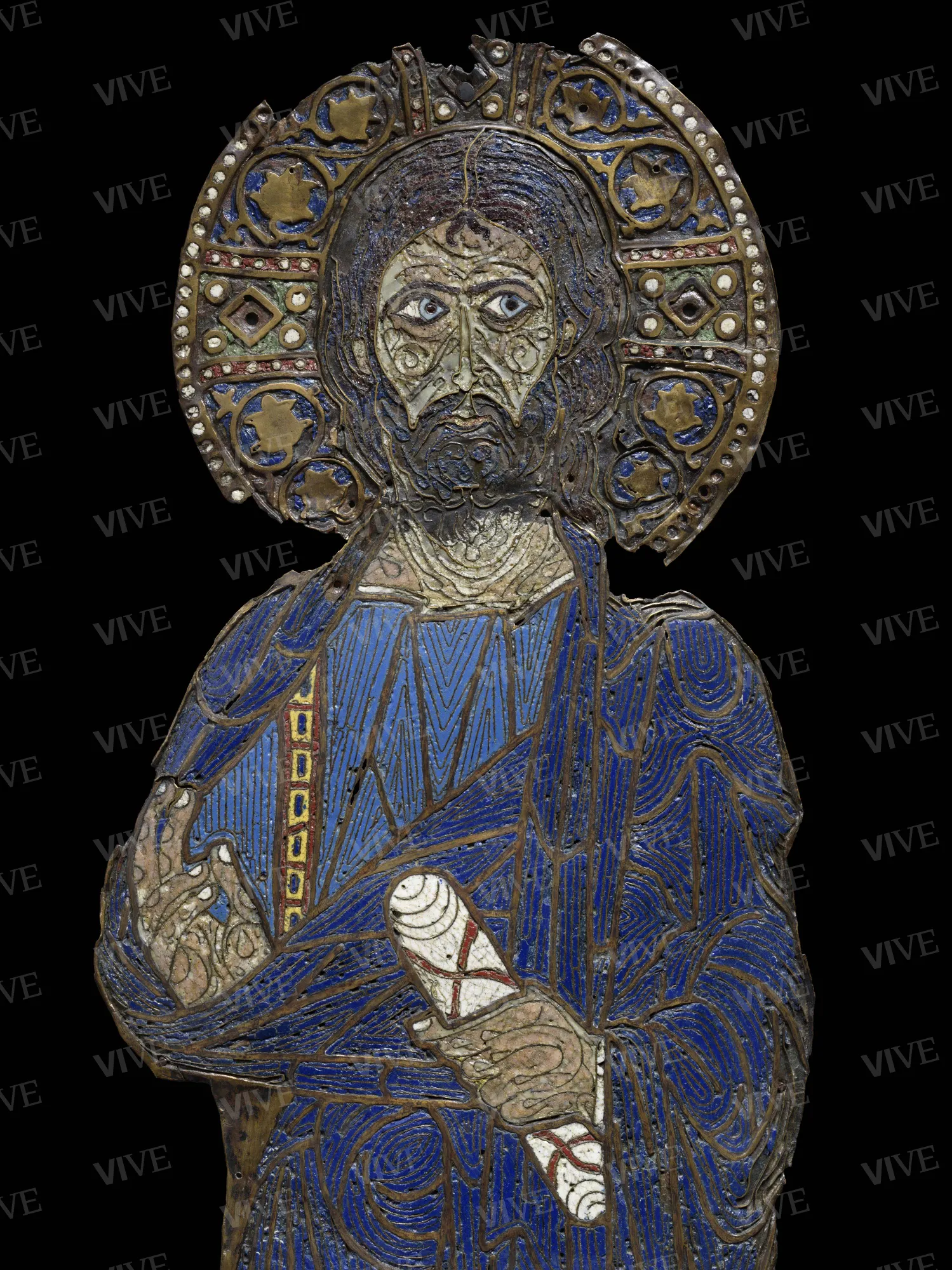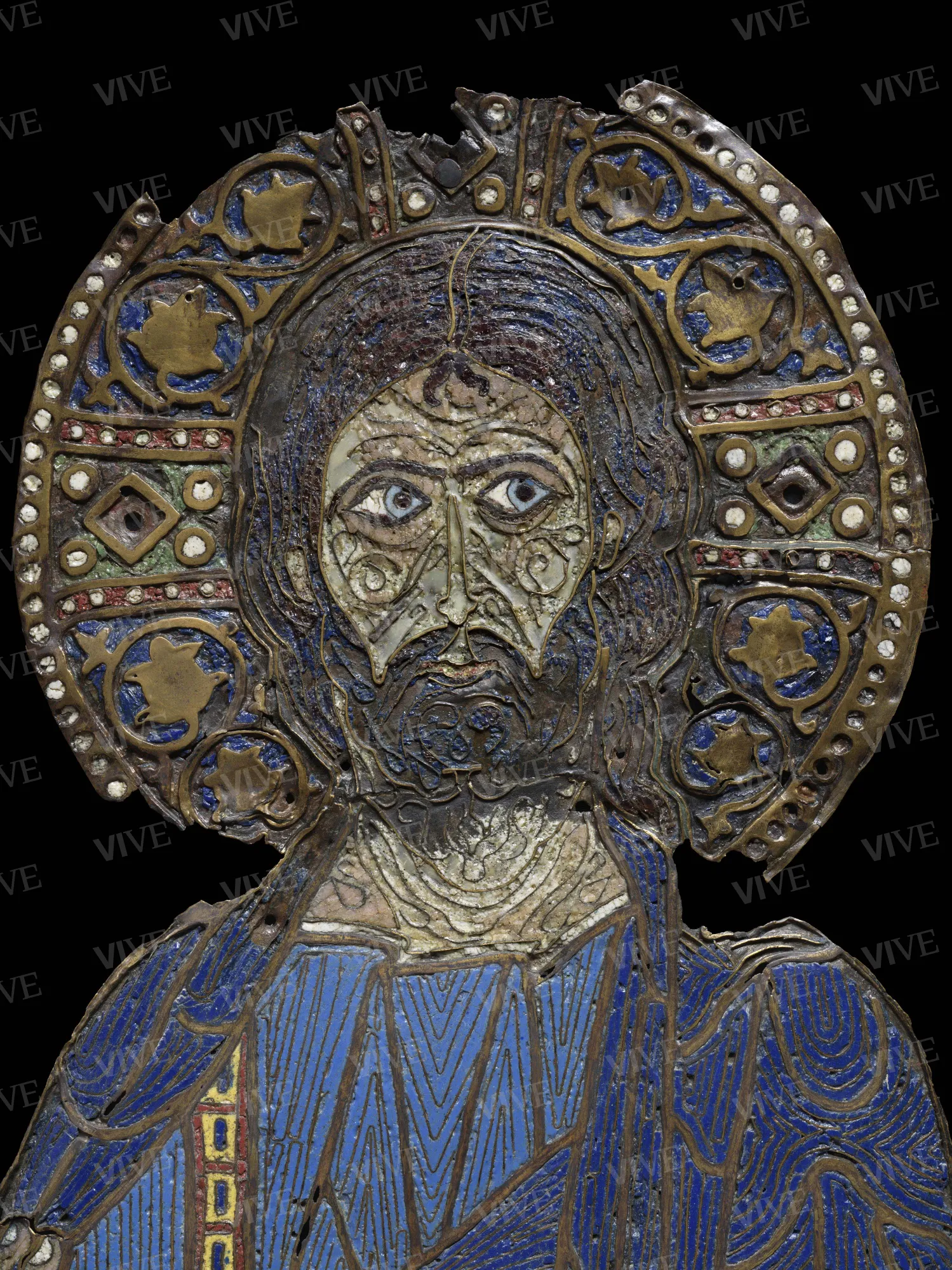Christ Pantocrator
Byzantine or Italian production Late-12th–early-13th century
Enamel on brass depicting Christ Pantocrator (that is, Ruler of all) in an upright position depicted blessing “in the Greek manner” with his right hand and tightly holding onto a scroll with his left hand; a crossed halo surrounds his head and contains a rosette decoration inserted within racemes, while colorful little flowers are scattered in the suppedaneum. The work is attributable to a Greek master who was active in Italy or to a Western artisan who was familiar with products of Byzantine art; it can be dated to the late twelfth and early thirteenth centuries.
Enamel on brass depicting Christ Pantocrator (that is, Ruler of all) in an upright position depicted blessing “in the Greek manner” with his right hand and tightly holding onto a scroll with his left hand; a crossed halo surrounds his head and contains a rosette decoration inserted within racemes, while colorful little flowers are scattered in the suppedaneum. The work is attributable to a Greek master who was active in Italy or to a Western artisan who was familiar with products of Byzantine art; it can be dated to the late twelfth and early thirteenth centuries.
Details of work
Catalog entry
The figure of Christ Pantocrator (that is, Christ the ruler of all) is in enamel on a large brass plate. The bearded Jesus is standing, his long hair parted in the center, blessing “in the Greek manner” with his right hand and tightly holding onto a scroll with his left hand; a crossed halo surrounds his head and contains a rosette decoration inserted within racemes reminiscent of Byzantine models. There are a series of colorful little flowers scattered in the suppedaneum, a traditional motif in eleventh- and twelfth-century Greek manuscripts. A blue mantle covers his blue robe, which is luxuriantly striped with a thin yellow band decorated with red and blue elements imitating gold and stones.
The figure was so large that it was undertaken in brass instead of gold; it is characterized by the use of both cloisonné and champlevé enamels. The latter technique is executed by means of a specific process, and in fact the hollows for the enamel are not made by engraving with a burin as is usual but, rather, through embossing. This specific process is found in Byzantine works or those that are influenced by the art of Byzantium where champlevé enamel is used. It was therefore widely used in Western goldsmithing from the Romanesque period onward.
The Palazzo Venezia artifact has been contextualized in various different ways. It has been traced to the second half or the end of the eleventh century (Bernardini 1917; Lipinsky 1967; Galasso 1969), to the twelfth century (Venturi 1899; Hermanin 1925; Hermanin 1948; Cecchelli 1951–1952), to the late twelfth century (Strinati 2006), to the twelfth–thirteenth centuries (Moretti 2007; Moretti 2014; De Giorgi 2009; Vigliarolo 2009), to the thirteenth century (Dalton 1911, turn of the century; Strinati 1999, end of the century; Nicita 2001; Vigliarolo 2009a), and assigned to Byzantium (Venturi 1899; Bernardini 1917; Toesca 1927), or, with some uncertainty, to a Byzantine master working in Italy (Dalton 1911, and fascinated by Limoges enamels; Moretti 2007; Moretti 2014), a Western master artisan familiar with Byzantine tropes (Moretti 2007; Moretti 2014), a Veneto–Byzantine workshop (De Giorgi 2009), as well as to Rome (Hermanin 1948), and/or to the milieu of the monks of Montecassino (Cecchelli 1951–1952; Lipinsky 1967; Galasso 1969), or, more generally, to central–southern Italy (Strinati 1999; Nicita 2001; Strinati 2006; Vigliarolo 2009; Vigliarolo 2009a).
Stylistically, there is a marked volumetric structuring of the face and overall gesture, while the robes are more stylized. The colors used are sparse yet of great effect; the eyes are a celestial blue, and, another distinctive feature, the complexion of the face, hands, and feet is made vibrant by the extensive use of cloisonné enameling. The piece, the original function of which is unknown (was it intended to be used as an altar frontal, was it a large enamel icon?), might possibly be part of a larger composition.
Simona Moretti
Entry published on 12 February 2025
State of conservation
Fair. The work is in two fragments and has lost some parts. No additions were made during the last restoration in all areas of enamel fall except in the face of Christ where the new insertions are undercut.
Restorations and analyses
Historical restorations (Adolfo Venturi describes the work as extensively restored, Venturi 1899);
1974–1976; Rome, Istituto Centrale del Restauro;
1984: Rome, Istituto Centrale del Restauro.
Provenance
Rome, Kircherian Museum: documented since 1709;
Rome, Museum of Castel Sant'Angelo: since 1913;
Rome, Museo di Palazzo Venezia: since 1920.
Exhibition history
Paris, Musée des Arts Décoratifs, Palais du Louvre, Pavillon de Marsan, Exposition internationale d’art byzantin, May 28–July 9, 1931;
Athens, Zappeion Exhibition Hall, Byzantine Art, a European Art, April 1–June 15, 1964;
Rome, Palazzo Venezia, Romei & Giubilei. Il pellegrinaggio medievale a San Pietro (350–1350), October 29, 1999–February 26, 2000;
Rome, Palazzo Venezia, Athanasius Kircher. Il museo del mondo, February 28–April 22, 2001;
Palermo, Palazzo dei Normanni, Nobiles officinae. Perle, filigrane e trame di seta dal Palazzo Reale di Palermo, December 17, 2003–March 10, 2004;
Vienna, Kunsthistorisches Museum, Nobiles officinae. Die königlichen Hofwerkstätten zu Palermo zur Zeit der Normannen und Staufer im 12. und 13. Jahrhundert, March 31–June 13, 2004;
Rome, Museo Nazionale, Palazzo Venezia, Sala Altoviti, Cipro e l’Italia al tempo di Bisanzio. L’Icona Grande di San Nicola tis Stegis del XIII secolo restaurata a Roma, June 23–July 26, 2009;
Venice, Museo Diocesano, Torcello: alle origini di Venezia tra Occidente e Oriente, August 29, 2009–January 10, 2010.
Sources and documents
Rome, Archivio del Museo Nazionale di Castel Sant’Angelo, provisional catalog, begun August 1, 1907, entry no. 1917;
Rome, Archivio fotografico dell’Istituto Centrale per il Restauro, Portale ARES, Fascicolo/i: 0138 e 0138b, essay on restoration of Christ Pantocrator (entry date: December 29, 1973; exit date: November 119, 1976, P. Fiorentino, V. Tancini, A. M. Carruba, M. Micheli, M. De Luca) with seven photographs;
Rome, Archivio del Museo Nazionale del Palazzo Venezia, Prot. 267, Posiz. 2 B/1, 07/03/1984 (copy of the restoration entryreport for Christ Pantocrator, with accompanying letter signed by the director of the Istituto Centrale del Restauro, Michele Cordaro, and dated February 29, 1984).
References
Bonanni Filippo, Museum Kircherianum, Roma 1709, pp. 317-318;
Marangoni Filippo, Istoria dell’antichissimo oratorio... appellato Sancta Sanctorum, Romae MDCCXLVII, p. 204;
Seroux d’Agincourt Jean-Baptiste-Louis-Georges, Histoire de l’Art par les monumens, depuis sa decadence au IVe siècle jusqu’à son renouvellement au XVIe, I-VI, Paris 1823 (II, p. 145; III, p. 161, Peinture; VI, pl. CLXVIII.3);
Venturi Adolfo, Lo smalto bizantino del Redentore, in «Le Gallerie Nazionali Italiane», 4, 1899, pp. 332-334;
Dalton Ormonde Maddock, Byzantine Art and Archaeology, Oxford 1911, p. 510;
Bernardini Giorgio, Il nuovo Museo di Palazzo Venezia. Arte Bizantina. Oggetti in osso e in avorio, in «Rassegna d’Arte», 17, 1917, pp. 25-44 (pp. 30-33, fig. 9);
Hermanin Federico, Il Palazzo di Venezia. Museo e grandi sale, Bologna 1925, p. 71;
Toesca Pietro, Storia dell’Arte Italiana. Il Medioevo, Torino 1927, p. 1115, p. 1118 fig. 819;
Exposition internationale d’art byzantin, catalogo della mostra (Parigi, Musée des Arts Décoratifs, Palais du Louvre, Pavillon de Marsan, 28 maggio-9 luglio 1931), Paris 1931, p. 148, n. 509, pl. XX;
Partecipazione italiana alla Mostra d’Arte Bizantina di Parigi 1931, Roma 1931, p. 23, n. 31, tav. XII;
Hermanin Federico, Il Palazzo di Venezia, Roma 1948, p. 325;
Cecchelli Carlo, La vita di Roma nel Medioevo, Roma 1951-1952, pp. 40, 51, fig. p. 41;
Ross Marvin Chauncey, Pantocrator, in Byzantine Art, a European Art, catalogo della mostra (Atene, Zappeion Exhibition Hall, 1 aprile-15 giugno 1964), Athens 1964, p. 408, n. 479;
Lipinsky Angelo, Oreficerie bizantine ed italo-bizantine nella regione campana, in «Corsi di Cultura sull’Arte Ravennate e Bizantina», 14, 1967, pp. 105-155;
Galasso Elio, Oreficeria medioevale in Campania, Benevento 1969 (Miniatura e arti minori in Campania, 4), p. 45, tav. XXX.a;
Strinati Tommaso, Pantocrator, in D’Onofrio Mario (a cura di), Romei & Giubilei. Il Pellegrinaggio medievale a San Pietro (350-1350), catalogo della mostra (Roma, Palazzo Venezia, 29 ottobre 1999-26 febbraio 2000), Milano 1999, p. 402, n. 201;
Negri Arnoldi Francesco, Il mestiere dell’arte. Introduzione alla storia delle tecniche artistiche, Napoli 2001, figg. 8-9;
Nicita Paola, Pantocrator, in Lo Sardo Eugenio (a cura di), Athanasius Kircher. Il museo del mondo, catalogo della mostra (Roma, Palazzo Venezia, 28 febbraio-22 aprile 2001), Roma 2001, pp. 49-51, n. I.2;
Strinati Tommaso, Placca con il Pantokrator, in Andaloro Maria (a cura di), Nobiles officinae. Perle, filigrane e trame di seta dal Palazzo Reale di Palermo, catalogo della mostra (Palermo, Palazzo dei Normanni, 17 dicembre 2003-10 marzo 2004; Vienna, Hofburg, Schweizerhof, Alte Geistliche Schatzkammer, 30 marzo-13 giugno 2004), I, Catania 2006, pp. 278-279, n. IV.9;
Moretti Simona, “Érga chymeutá”: icone a smalto dell’XI e XII secolo tra Bisanzio e l’Occidente, in Quintavalle Arturo Carlo (a cura di), Medioevo mediterraneo: l’Occidente, Bisanzio e l’Islam, Atti del convegno (Parma, 21-25 settembre 2004), Milano 2007, pp. 341-350;
De Giorgi Manuela, Placca col Pantocratore, in Caputo Gianmatteo, Gentili Giovanni (a cura di), Torcello: alle origini di Venezia tra Occidente e Oriente, catalogo della mostra (Venezia, Museo Diocesano, 29 agosto 2009-10 gennaio 2010), Venezia 2009, p. 166, n. 24, fig. a p. 73;
Vigliarolo Carolina, Cristo Pantocrator, in Eliades Ioannis A. (a cura di), Cipro e l’Italia al tempo di Bisanzio. L’Icona Grande di San Nicola tis Stegis del XIII secolo restaurata a Roma, catalogo della mostra (Roma, Museo Nazionale del Palazzo Venezia, Sala Altoviti, 23 giugno-26 luglio 2009), Nicosia 2009, pp. 235-237, n. 4;
Vigliarolo Carolina, Cristo Pantocrator, in Barberini Maria Giulia, Sconci Maria Selene (a cura di), Guida al Museo Nazionale del Palazzo di Venezia, con prefazione di Strinati Claudio, Roma 2009, p. 56, n. 53 (Vigliarolo 2009a);
Moretti Simona, Roma bizantina. Opere d’arte dall’impero di Costantinopoli nelle collezioni romane, Roma 2014, pp. 82, 239-242 (n. 18), 275 et passim, figg. 100-101, tav. a colori VIII.


